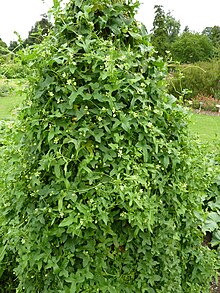Bryonia dioica
This article includes a list of general references, but it lacks sufficient corresponding inline citations. (May 2011) |
| Bryonia dioica | |
|---|---|

| |
| Scientific classification | |
| Kingdom: | Plantae |
| Clade: | Tracheophytes |
| Clade: | Angiosperms |
| Clade: | Eudicots |
| Clade: | Rosids |
| Order: | Cucurbitales |
| Family: | Cucurbitaceae |
| Genus: | Bryonia |
| Species: | B. dioica
|
| Binomial name | |
| Bryonia dioica Jacq. non M.Bieb. non Bojer non Sessé & Moc.
| |
Bryonia dioica, known by the common names red bryony and white bryony,[1] also English mandrake or ladies' seal,[2] is a perennial climbing vine indigenous to Central and Southern Europe. It is a flowering plant in the cucumber family Cucurbitaceae with five-pointed leaves and blue or white flowers. The vine produces a red berry fruit.
Toxicity[edit]
Bryonia dioica is generally toxic to humans. Application of its juice to the skin produces inflammation with a rash or ulcers, and consumption of this juice causes intense gastrointestinal irritation including nausea and vomiting in small doses, and anxiety, paralysis, or death in larger amounts.[citation needed]
The seed of this vine, by contrast, is safely edible, and finds use in Western Europe as an ingredient in starch dishes.[citation needed]
Herbalism[edit]
The plant is sometimes used in herbalism. In medieval times, the plant was thought to be an antidote for leprosy.[2]
The root can be 75 cm (30 in) long and 75 mm (3.0 in) thick. John Gerard's Herball (1597) states that: "The Queen's chief surgeon, Mr. William Godorous, a very curious and learned gentleman, shewed me a root hereof that waied half an hundredweight, and of the bignes of a child of a yeare old."[2]
It can be used fresh at any time of the year. It can also be harvested in the autumn and be dried for later use.[citation needed]
Gallery[edit]
-
Flowers of Bryonia dioica
References[edit]
- ^ Sterry, Paul (2006). Collins Complete Guide to British Wild Flowers. London: HarperCollins. p. 114. ISBN 978-0-00-723684-8.
- ^ a b c Grieve, Maud (1971). A Modern Herbal: The Medicinal, Culinary, Cosmetic and Economic Properties, Cultivation and Folk-lore of Herbs, Grasses, Fungi, Shrubs, & Trees with All Their Modern Scientific Uses, Volume 1. p. 132. ISBN 9780486227986.








